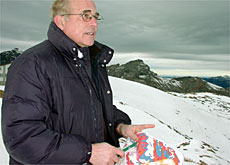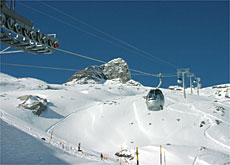Canadian has designs on Swiss ski resorts

Swiss ski resorts are under pressure to modernise in order to remain competitive and many have turned to a Canadian for advice.
swissinfo met up with the ski resort designer, Paul Mathews, on a recent visit to Switzerland and asked him for his evaluation of Swiss mountain resorts.
Mathews and his company, Ecosign, played a key role in the design of the Canadian resort of Whistler, considered by many to be the best ski resort in the world. Whistler will host the alpine ski events at the 2010 Winter Olympics in Vancouver.
Ecosign has built or redeveloped ski resorts in more than 20 countries and is involved in creating a multibillion-dollar ski region near the Russian resort of Sochi where Russia’s President Vladimir Putin has a holiday home.
The resorts of Zermatt, Verbier and Davos are among his Swiss clients and he has presented a master plan for the creation of a mega ski region linking Titlis with Melchsee Frutt and Meiringen Hasliberg.
swissinfo: Why do you see more growth potential for Swiss resorts than the Swiss do?
Paul Mathews: We Canadians are much more optimistic than the Swiss. They feel restricted because the amount of available land is limited, the market is small and so is the potential. I, as a Canadian, regard the glass as half full; they see it as half empty.
swissinfo: Your company, Ecosign, is active in building or redeveloping ski resorts in more than 20 countries. How do Swiss ski resorts rate on a global scale?
P.M.: I look at it in three different ways. The mountains and snow conditions are more or less excellent here – world class. Secondly, the Swiss are good managers. But what I find missing, and what I hope I can contribute to, is the overall planning and organisation.
They [the Swiss] always do things in incremental, small steps and often there is a lack of coordination when new infrastructure is built. The lift never goes quite to the top to connect with the next lift, or the ski run has a flat section that you have to walk through. This is not very comfortable if you are a snowboarder or not a good skier.
swissinfo: The Swiss are envious of the success of Austrian ski resorts, which have seen turnover rise over the past few years while visitor numbers in Switzerland have stagnated or declined. For skiers, are Austrian resorts simply better?
P.M.: The Austrians are ten years ahead of the Swiss in realising what needs to be done to keep up with the times. But I find the ski slopes in many Austrian resorts overcrowded. For example, they replace T-bars with two-person chairlifts, then with a triple chair, then a quad and eventually an eight-person chair lift without widening the slope or building more runs. The Austrians are moving towards industrial tourism, so I guess my preference would be somewhere between the two.
swissinfo: How difficult is it to convince the Swiss to listen to an outsider?
P.M.: At first they laughed at my ideas, like it was some kind of a joke, but now that I have references from leading Swiss resorts I have a lot more credibility. They say, “that’s the guy who did that place”. My reputation precedes me now.
swissinfo: What methods do you use in analysing resorts?
P.M.: We rely a lot on technical tools. We use topographical maps to make computer models and we have some rather special and rigorous tests for slope exposure and elevation, avalanche risk and wind direction. We also measure the existing infrastructure to see how balanced it is. The restaurant capacity should equal the chair-lift capacity, which should equal the number of beds, which should correspond to the number of ski runs and parking places, and so on. It should all match but it seldom does, so any investment spent on too much of one thing is more or less wasted.
swissinfo: Switzerland has many Asian and American visitors in summer, but few in winter. Why?
P.M.: Poorly planned investments are costly and inevitably the costs are passed on to the consumer. Japanese skiers can spend a week in Whistler for about SFr1,200 ($950) but would pay three times as much to come to Switzerland.
swissinfo: You draw up master plans for resorts, so resorts can have solid growth over a 20-year period. But what kind of skiing industry will be left in 20 years if predictions of warmer winters due to global warming come true?
P.M.: In my opinion, it will be safe to ski above 1,400 or 1,600 metres in the Alps. The problem is that a lot of young kids learn to ski at lower resorts close to their homes and that will be a challenge if these places disappear. And if snow no longer falls in cities like Lucerne, Zurich or Bern, people will lose the desire to head for the mountains and go skiing. That worries me more than losing small, low-lying resorts.
swissinfo-interview, Dale Bechtel
Paul Mathews of Ecosign is one of the world’s leading mountain resort planners.
The company has played a key role in the redevelopment of several Swiss resorts, including Davos, Zermatt and Flims-Laax-Falera.
It devises feasibility studies and master plans for the building or redevelopment of resorts and their ski areas.

In compliance with the JTI standards
More: SWI swissinfo.ch certified by the Journalism Trust Initiative


You can find an overview of ongoing debates with our journalists here . Please join us!
If you want to start a conversation about a topic raised in this article or want to report factual errors, email us at english@swissinfo.ch.